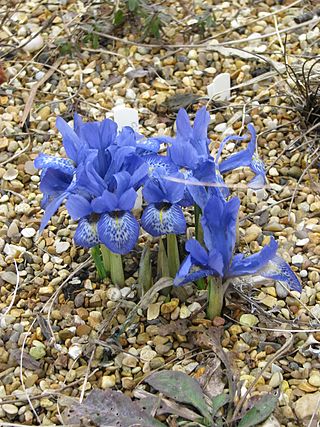
Iris histrioides, the orchis iris, winter iris or Harput iris, is a species of flowering plant in the genus Iris, subgenus Hermodactyloides of the family Iridaceae. It is a bulbous perennial, that is native to Turkey, and has blue, scented flowers. It is cultivated as an ornamental plant in temperate regions, and has many known cultivars.
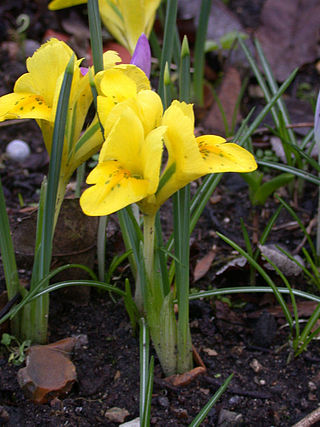
Iris danfordiae, the dwarf iris or Danford iris, is a bulbous perennial plant in the genus Iris, it is classified in the subgenus Hermodactyloides and section Reticulatae. It is from Turkey in Asia. It has 2 gray-green or bluish green, thick leaves, short slender stem holding a scented flower, in shades of yellow. They are spotted olive-green or green and have a deep yellow or orange crest.
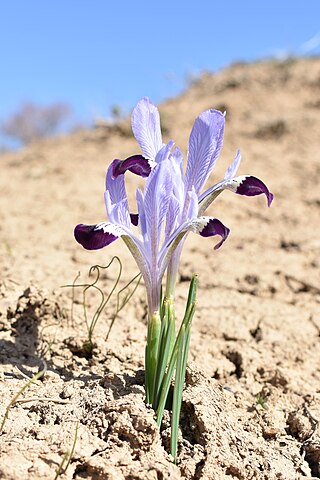
Iris kolpakowskiana, or Kolpakowski's iris, is a plant species in the genus Iris, it is classified in the subgenus Hermodactyloides and section Monolepsis. It is a bulbous perennial from Asia.

Iris winkleri, or Winkler iris, is a species in the genus Iris, classified in the subgenus Hermodactyloides and section Monolepsis. It is a bulbous perennial from Turkestan, in Central Asia.

Iris histrio, the Syrian iris, is a species in the genus Iris, it is classified in the subgenus Hermodactyloides and section Reticulatae. It is a bulbous perennial from Central Asia: Kyrgyzstan, Israel, Lebanon, Syria and southern Turkey.

Iris planifolia is a species of flowering plant in the subgenus Scorpiris of the genus Iris, family Iridaceae. This bulbous perennial from Southern Europe and North Africa has long, shiny green leaves, a short stem, and large scented flowers in various shades of blue.
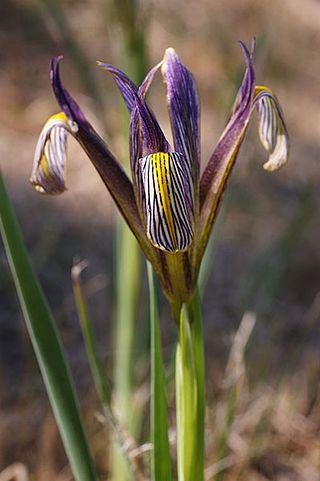
Iris masia, commonly known as the barbed iris, is a species in the genus Iris, it is also in the subgenus Limniris and in the series Syriacae. It is a rhizomatous perennial from the Middle East and Asian Turkey. It has long grass-like leaves, unbranched stems with single flowers in late spring, in shades from purple to violet blue.
Iris kobayashii is a beardless iris in the genus Iris, in the subgenus Limniris and in the series Tenuifoliae of the genus. It is a rhizomatous herbaceous perennial, from China. It has slightly twisted leaves, short stems and 1 to 2 purple or blue and yellow flowers.
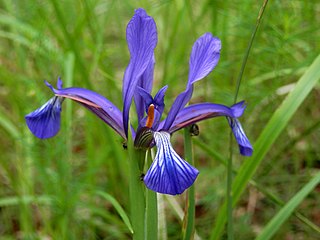
Iris sintenisii is a species in the genus Iris, it is also in the subgenus Limniris and in series Spuriae, with tall thin stems, violet-blue flowers and long grass-like leaves. It is a rhizomatous perennial plant, from grass meadows parts of Europe, Russia, and Turkey. It is cultivated as an ornamental plant in temperate regions.
Iris spuria subsp. musulmanica is a species of the genus Iris, part of a subgenus known as Limniris and in the series Spuriae. It is a subspecies of Iris spuria and is a rhizomatous perennial plant, from Armenia, Azerbaijan, Iran and Turkey in Asia with flowers in various shades of blue, but there are rare white forms. They have a yellow centre and darker veining. It has the common name of 'Muslim iris'. It is cultivated as an ornamental plant in temperate regions.
Iris mandshurica is a species in the genus Iris, it is also in the subgenus of Iris and in the Psammiris section. It is a rhizomatous perennial, it is found in Russia, China, and Korea. It has green sword-like leaves, smooth green stem and yellow flowers, with yellow-purple veining and a yellow beard. It is cultivated as an ornamental plant in temperate regions.
Iris leptophylla is a plant species in the genus Iris, it is also in the subgenus Iris and in the section Pseudoregelia. It is a rhizomatous perennial, from China. It has thin, long grey-green leaves, long slender stem and 2 fragrant purple, blue-purple, violet or lavender pink flowers. It is cultivated as an ornamental plant in temperate regions.
Iris griffithii is a plant species in the genus Iris, it is also in the subgenus Iris. It is a rhizomatous perennial, from Afghanistan. It has short, sickle-shaped leaves, short green stem and purple flowers with white beards. Several specimens exist within herbaria around Europe, but it is rarely cultivated.

Iris junonia is a plant species in the genus Iris, it is also in the subgenus Iris. It is a rhizomatous perennial, from Cilicia, within the Taurus Mountains. It has glaucous short leaves, tall stems with several branches, numerous flowers in various colours from blue-purple, lavender, pale blue, cream, white and yellow, with brown veining and white tipped orange beards. It is cultivated as an ornamental plant in temperate regions. Its status is still unclear, if it is a synonym of Iris germanica or a separate species.
Iris purpureobractea is a plant species in the genus Iris, it is also in the subgenus Iris. It is a rhizomatous perennial, from the cliffs and forest glades on the mountains of Turkey. It has straight or falcate shaped leaves, stem with several branches, the stem has purple spathes, it has up to 8 fragrant flowers, in various colours between yellow or blue. It is cultivated as an ornamental plant in temperate regions.
Iris schachtii is a plant species in the genus Iris, it is also in the subgenus Iris. It is a rhizomatous perennial, from central Anatolia, in Turkey. It has small, thin grey-green leaves, a short stem with 1–3 branches, which are normally, covered with a green leaf with purple staining. It has 2 or more fragrant flowers in late spring, which come in shades of yellow or purple, or violet and yellow,. It has a yellow or white with yellow-tips beard. It is cultivated as an ornamental plant in temperate regions, but prefers regions with dry, hot summers.
Iris taochia is a plant species in the genus Iris, it is also in the subgenus Iris. It is a rhizomatous perennial, from the Caucasus mountains and Turkey. It forms dense clumps, with grey-green leaves, simple stems of similar height, with 1–3 branches, a flowers in various shades from white, yellow to purple. They also have yellowish or white, tipped yellow beard. It is cultivated as an ornamental plant in temperate regions.

Iris acutiloba is a species in the genus Iris, it is also in the subgenus of Iris and section Oncocyclus. It is a rhizomatous perennial, from the mountains of the Caucasus and found in Turkey, Armenia, Azerbaijan, Turkmenistan, Dagestan in the North Caucasus, and Iran. It is a dwarf species, with narrow, falcate or curved leaves, it has one flower in spring or early summer, that comes in shades from cream, creamy white, whitish, pale brown, light grey, to pale violet. It is heavily veined or streaked and pointed, with 2 dark spots and brown, purple, dark purple, or black short beard. It is cultivated as an ornamental plant in temperate regions. There are two subspecies, Iris acutiloba subsp. lineolata and Iris acutiloba subsp. longitepala.
Iris basaltica is a species in the genus Iris, it is also in the subgenus Iris and in the section Oncocyclus. It is a rhizomatous perennial, from the basalt deserts and hillsides of eastern Syria. It has many falcate long leaves, and long stem. Between March and April, it has white or pale green flowers covered in thick purple or black veining and dots or spots. It also has a purple or maroon beard, tipped with yellow. It is rare cultivated as an ornamental plant in temperate regions, due to its environmental conditions of its natural habitat.
Iris grossheimii is a plant species in the genus Iris, subgenus Iris and section Oncocyclus. It is a rhizomatous perennial, from the Caucasus mountains of Georgia, Armenia and Azerbaijan. It has sickle shaped leaves, which are as long as the short stem, which carries one flower in spring. It is beige, pink or brown covered in dark lines that are, purple-brown or brown. It has a large blackish brown signal patch and brown or black beard. It is rarely cultivated as an ornamental plant in temperate regions, as it needs very dry conditions during the summer.









